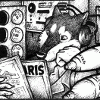
When talking about Soviet strategic interceptors of the 1970s and 1980s, students of the Soviet airpower must have been intimately familiar with Mikoyan's Mach-3 beast the MiG-25 "Foxbat". However, the backbone of the Soviet air defense force (V-PVO) at the time was still mainly composed of older, more ubiquitous Sukhoi Su-15 "Flagon".
The Su-15 was designed in the early 1960s as its predecessor the Su-9 and Su-11 "Fishpots" were deemed unsuitable to intercept newer B-52 Stratofortress bombers and partly to keep up with Mikoyan's MiG-21 "Fishbed" and Yakovlev's Yak-27 "Flashlight" interceptors that have been favored by the red air force.
The first Su-15 Variant made its first flight in 1962 and entered service from 1967, the "Flagon-A" shared a lot of characteristics with its predecessor. Its main differences were the solid, conical nosecone housing the RP-22 Oryol-D "Skip Spin" radar, fuselage-side intakes, and the twin Tumanskii R-11 engines. A trainer variant with a tandem cockpit and no radar and combat capability was also developed as Su-15UT "Flagon-C".
Initial delta-winged Su-15 had poor take-off and landing characteristics, and so Sukhoi investigated a new wing design with extended wingtips and boundary layer control, giving it a characteristic "kink" on the wing leading edge. Su-15 with the new wing went into production in 1969 and was dubbed "Flagon-D" by NATO, although Soviet designation was unchanged.
In 1969, the Oryol radar that had been carried from Su-11 was replaced by Taifun radar based on MiG-25's RP-25 Smerch-A "Foxfire", resulting in the Su-15T. The Taifun radar proved troublesome, however, and ceased production after only 10 aircraft had been built. In addition to the new radar, Su-15T was also equipped with more powerful Tumanskii R-13 engines and a twin nose wheel to handle the additional weight of the Taifun radar.
Volkov OKB finally came up with a workable radar design in 1971 dubbed Taifun-M "Twin Scan" radar. Production continues with the new aircraft given the updated designation of Su-15TM "Flagon-E". Su-15TM becomes the definitive variant of the Su-15 family with the provision to carry R-60 heat-seeking missiles and UPK-23-250 gun pods in addition to K-8 missiles. When the original conical nosecone turned out to generate echoes from the powerful Taifun-M radar, the nosecone was changed to an ogival shape, with NATO assigning the variant the reporting name of "Flagon-F" despite Soviet designation again remains unchanged.
The final development of Su-15, a combat-capable trainer comparable to the Su-15TM called Su-15UM "Flagon-G" rolled out in 1976. Although it was not equipped with radar, it could still carry R-60 heat-seeking missiles and UPK-23-250 gun pods.
As newer, more capable MiG-25 are entering active service in the 1970s, the Su-15 was relegated to intercepting slower B-52, U-2, and British V-bombers, while leaving faster targets such as B-58. XB-70 and SR-71 to the MiG-25. Although it never shot down its intended targets throughout its service life, its ubiquity in the PVO has led to several shooting-down incidents involving foreign civilian aircraft that strayed into the Soviet airspace.
The first such incident occured in 1978, when Korean Air Lines Flight 902 veered into Soviet airspace due to navigation error and was attacked over Murmansk by a PVO Su-15. The Boeing 707 survived the missile hit and made an emergency landing on frozen Korpijärvi lake near the Finnish border. Unfortunately, two passengers lost their lives and several were wounded by the missile shrapnel.
Next was the 1981 mid-air collision with Canadair CL-44 of the Transporte Aéreo Rioplatense that was delivering arms from Israel to Iran as part of the Iran-Contra Affair.
The third, and arguably the most infamous was the shot down of Korean Air Lines Flight 007 in 1983. The Boeing 747-200B was flying from Anchorage to Seoul when it strayed into Soviet airspace over Sakhalin due to an autopilot issue. It was intercepted by two Su-15s whose pilots tried to get the jetliner crew to follow them and land, but there was no response. One of the Su-15 fired warning shots with cannons; again no response. Apparently, on the assumption that the 747 was a US RC-135 aircraft, which had the same broad configuration, the Su-15s were then ordered to destroy the intruder. Major Gennady Osipovich pumped two K-8 Missiles into it, telling ground control tersely: "The target is destroyed." The 747 fell into the Sea of Japan, with all 269 onboard killed. I will elaborate on the series of unfortunate events that led to the shot down in more detail on my finished painting.
Drawing this scene proved to be a challenge as both aircraft have very delicate curves that will not look right if not drawn correctly. Thankfully, owed to the prevalence of Su-15 and 747, it was quite easy to find reference drawings and photos. Even then, I'm still not quite happy with how the 747's "hump" turned out .
The infamous "Red 17" was of Su-15TM "Flagon-F" variant with ogival nose while HL7442 was a 747-230B with P&W JT9D engines. Maj. Osipovich expended both his K-8 missiles in the attack, but I'm not quite sure if his aircraft carried the R-60 missiles. Possibly two UPK-23-250 gun pods were carried which were used to fire warning shots, but will not be visible at this angle.
In real life, the separation of both aircraft was measured in kilometers (Maj. Osipovich opened fire from below rear at 2.000 m). Therefore I opted for a very narrow field of view reducing the effect of depth from perspective, though in turn making the aircraft looks almost orthogonal.
The Su-15 was designed in the early 1960s as its predecessor the Su-9 and Su-11 "Fishpots" were deemed unsuitable to intercept newer B-52 Stratofortress bombers and partly to keep up with Mikoyan's MiG-21 "Fishbed" and Yakovlev's Yak-27 "Flashlight" interceptors that have been favored by the red air force.
The first Su-15 Variant made its first flight in 1962 and entered service from 1967, the "Flagon-A" shared a lot of characteristics with its predecessor. Its main differences were the solid, conical nosecone housing the RP-22 Oryol-D "Skip Spin" radar, fuselage-side intakes, and the twin Tumanskii R-11 engines. A trainer variant with a tandem cockpit and no radar and combat capability was also developed as Su-15UT "Flagon-C".
Initial delta-winged Su-15 had poor take-off and landing characteristics, and so Sukhoi investigated a new wing design with extended wingtips and boundary layer control, giving it a characteristic "kink" on the wing leading edge. Su-15 with the new wing went into production in 1969 and was dubbed "Flagon-D" by NATO, although Soviet designation was unchanged.
In 1969, the Oryol radar that had been carried from Su-11 was replaced by Taifun radar based on MiG-25's RP-25 Smerch-A "Foxfire", resulting in the Su-15T. The Taifun radar proved troublesome, however, and ceased production after only 10 aircraft had been built. In addition to the new radar, Su-15T was also equipped with more powerful Tumanskii R-13 engines and a twin nose wheel to handle the additional weight of the Taifun radar.
Volkov OKB finally came up with a workable radar design in 1971 dubbed Taifun-M "Twin Scan" radar. Production continues with the new aircraft given the updated designation of Su-15TM "Flagon-E". Su-15TM becomes the definitive variant of the Su-15 family with the provision to carry R-60 heat-seeking missiles and UPK-23-250 gun pods in addition to K-8 missiles. When the original conical nosecone turned out to generate echoes from the powerful Taifun-M radar, the nosecone was changed to an ogival shape, with NATO assigning the variant the reporting name of "Flagon-F" despite Soviet designation again remains unchanged.
The final development of Su-15, a combat-capable trainer comparable to the Su-15TM called Su-15UM "Flagon-G" rolled out in 1976. Although it was not equipped with radar, it could still carry R-60 heat-seeking missiles and UPK-23-250 gun pods.
As newer, more capable MiG-25 are entering active service in the 1970s, the Su-15 was relegated to intercepting slower B-52, U-2, and British V-bombers, while leaving faster targets such as B-58. XB-70 and SR-71 to the MiG-25. Although it never shot down its intended targets throughout its service life, its ubiquity in the PVO has led to several shooting-down incidents involving foreign civilian aircraft that strayed into the Soviet airspace.
The first such incident occured in 1978, when Korean Air Lines Flight 902 veered into Soviet airspace due to navigation error and was attacked over Murmansk by a PVO Su-15. The Boeing 707 survived the missile hit and made an emergency landing on frozen Korpijärvi lake near the Finnish border. Unfortunately, two passengers lost their lives and several were wounded by the missile shrapnel.
Next was the 1981 mid-air collision with Canadair CL-44 of the Transporte Aéreo Rioplatense that was delivering arms from Israel to Iran as part of the Iran-Contra Affair.
The third, and arguably the most infamous was the shot down of Korean Air Lines Flight 007 in 1983. The Boeing 747-200B was flying from Anchorage to Seoul when it strayed into Soviet airspace over Sakhalin due to an autopilot issue. It was intercepted by two Su-15s whose pilots tried to get the jetliner crew to follow them and land, but there was no response. One of the Su-15 fired warning shots with cannons; again no response. Apparently, on the assumption that the 747 was a US RC-135 aircraft, which had the same broad configuration, the Su-15s were then ordered to destroy the intruder. Major Gennady Osipovich pumped two K-8 Missiles into it, telling ground control tersely: "The target is destroyed." The 747 fell into the Sea of Japan, with all 269 onboard killed. I will elaborate on the series of unfortunate events that led to the shot down in more detail on my finished painting.
Drawing this scene proved to be a challenge as both aircraft have very delicate curves that will not look right if not drawn correctly. Thankfully, owed to the prevalence of Su-15 and 747, it was quite easy to find reference drawings and photos. Even then, I'm still not quite happy with how the 747's "hump" turned out .
The infamous "Red 17" was of Su-15TM "Flagon-F" variant with ogival nose while HL7442 was a 747-230B with P&W JT9D engines. Maj. Osipovich expended both his K-8 missiles in the attack, but I'm not quite sure if his aircraft carried the R-60 missiles. Possibly two UPK-23-250 gun pods were carried which were used to fire warning shots, but will not be visible at this angle.
In real life, the separation of both aircraft was measured in kilometers (Maj. Osipovich opened fire from below rear at 2.000 m). Therefore I opted for a very narrow field of view reducing the effect of depth from perspective, though in turn making the aircraft looks almost orthogonal.
Category All / All
Species Unspecified / Any
Size 1220 x 848px
File Size 277.8 kB
"RP-25 Smerch-A "Foxfire"" - Awesome! ;)
Thanks for the summary of a lesser known aircraft Graue and this picture looks great already!
And huh, weird...I have the book 'Shootdown - The Verdict on KAL 007' by R.W. Johnson and thought I'd read it, but apparently I haven't yet.
All I can say is that for a plane shot down in an alleged spying incident* the callsign 007 was either an extraordinary coincidence or something was up.
*I don't believe for a second that KAL 007 itself was spying, but it may have been used in some way in the intelligence gathering that was taking place at that time without its knowledge, if I recall correctly a Soviet ICBM test was taking place in the area at the same time as 007's flight and as you say a RC-135 was nearby to watch it.
Thanks for the summary of a lesser known aircraft Graue and this picture looks great already!
And huh, weird...I have the book 'Shootdown - The Verdict on KAL 007' by R.W. Johnson and thought I'd read it, but apparently I haven't yet.
All I can say is that for a plane shot down in an alleged spying incident* the callsign 007 was either an extraordinary coincidence or something was up.
*I don't believe for a second that KAL 007 itself was spying, but it may have been used in some way in the intelligence gathering that was taking place at that time without its knowledge, if I recall correctly a Soviet ICBM test was taking place in the area at the same time as 007's flight and as you say a RC-135 was nearby to watch it.
I was driving back to Tucson from Fullerton California when 007 was shot down. Immediately the chatter was the call sign was '007' and a "Spy Flight" Orchestrated by South Korea and the US. Scoop Jackson got upset about this and died from a Aneurysm shortly after giving a press conference. And when Reagan played the intercepted radio transmissions from the Soviet Pilot announcing the shoot down. The Soviets quickly denying it. The Soviets also had a extensive history of shooting down civilian airliners that got too close or accidentally strayed into Soviet air space. Not to mention numerous reconnaissance flights by US, British, European/Nato nations. Even a hot air balloon that drifted across Poland into Belarus in 1995, killing the two Americans on board. Chinese were trigger happy too, shooting down numerous US, Taiwanese and Korean aircraft.
Yet you never hear of the US shooting down Soviet recon aircraft or those that stray into US air space.
Yet you never hear of the US shooting down Soviet recon aircraft or those that stray into US air space.
True that, but at the same time, the Iranians were making serious saber rattling and motions at the same time and proven to shoot first, ask questions later. Even the video of the Vincennes crew were utterly stunned when they found out they shot down an Iranian Airliner.
Again, The Soviets, later the Russians were more trigger happy, Look at the recent KLM Flight 17 and Even the Iranians popped off the UIA Flight 792 as it left Tehran .
But the Soviets are more notorious to be trigger happy on airliners and Recon aviation.
Again, The Soviets, later the Russians were more trigger happy, Look at the recent KLM Flight 17 and Even the Iranians popped off the UIA Flight 792 as it left Tehran .
But the Soviets are more notorious to be trigger happy on airliners and Recon aviation.
There was a lot of political backlash against the Soviets over the shootdown of of KAL Flight 007. 1983 was a particularly low point in relations between the East and West. There was a lot of tension after that shootdown, and just a few weeks later we came within a hair's breadth of a nuclear exchange. Thankfully that didn't happen due to the cool-headed judgement of Colonel Stanislav Petrov. It's absolutely terrifying to think about how close we were.
Some time, I think you ought to also explore the shootdown of Vega 31 over Serbia in 1999. That's another incident which I find extremely fascinating, in terms of the technology, tactics, and all the events surrounding what happened, as well as the meeting and subsequent friendship years later between the pilot and the SAM battery commander who shot him down.
Some time, I think you ought to also explore the shootdown of Vega 31 over Serbia in 1999. That's another incident which I find extremely fascinating, in terms of the technology, tactics, and all the events surrounding what happened, as well as the meeting and subsequent friendship years later between the pilot and the SAM battery commander who shot him down.

 FA+
FA+




















Comments